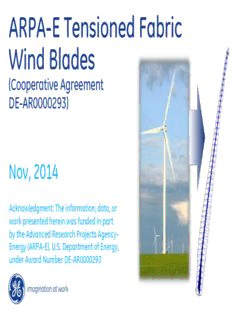
ARPA-E Tensioned Fabric Wind Blades PDF
Preview ARPA-E Tensioned Fabric Wind Blades
ARPA-E Tensioned Fabric Wind Blades (Cooperative Agreement DE-AR0000293) Nov, 2014 Acknowledgment: The information, data, or work presented herein was funded in part by the Advanced Research Projects Agency- Energy (ARPA-E), U.S. Department of Energy, under Award Number DE-AR0000293 Project Description ARPA-E Project DE-AR0000293 • Develop a novel wind blade technology in which a space frame structure is covered by tensioned fabric • Aim for blade lifecycle cost & LCoE reduction through new blade architecture & manufacturing method 2 Existing Fabric Structures Wind Turbine Space Frame Tower Tension Fabric Denver Airport Fabric Airplane Sail Boat BMW GINA Concept Car Tent 3 Challenges of Fabric on Wind Blades A Space Frame Wind Fabric deformation shape under aero pressure Blade Structure Long unsupported span & high Deformed shape static & dynamic load lead to Original airfoil shape high blade deflection & skin deformation Significant AEP reduction & LCoE increase if high fabric deflection at FWD 50% chord Fabric pre-tension required to avoid sag under blade deflection to maintain aero shape Down-selected to glass fiber reinforced fabric: Candidate fabrics • Pros: • Damage tolerance • Environment performance (20-year field exposure) • Low relaxation to avoid up-tower re-tensioning • Low cost • Cons: • High modulus leads to high fabric tension load How to apply pre-tension & retain tension on fabric to maintain aero shape in 4 a cost-effective way? Fabric Roughness Wind Tunnel Test Test description: 3 candidate fabrics with varying roughness characteristics are wrapped around existing airfoil models and aerodynamically characterized in the VT Stability Wind Tunnel Goal of the test: Quantify the aero losses due to the roughness characteristics of each fabric on relevant airfoil cross sections and determine if they are viable candidates for fabric down select Fabric Description Baseline Fabric A • High roughness (average and peak) Normalized Lift/Drag Fabric B • Low roughness (average and peak) • High roughness wavelength Tripped Fabric C • Low roughness (similar to Fabric B) Increasing • Low roughness wavelength Roughness Findings: Sufficiently high losses for Fabric A that it was no longer considered a viable candidate for down select Small losses for Fabrics B and C 55 Tensioned Fabric Blade (TFB) Evolution 1: Truss Structures with Fabric Tension & Attachment Box beam w structural LE & TE D-beam w structural TE Box-beam w structural LE & non-structural TE • < 3% weight saving due to added mass to maintain buckling margin of LE/TE/ribs • Complex fabric pre-tension mechanism • Significant technical risk on joints & fabric attachment 6 Unlikely to meet cost saving target TFB Evolution 2: D-Beam with Non- Structural Trailing Edge (TE) Cost Comparison D-beam • D-beam designed to take all load. • Non-structural TE panel to keep airfoil shape • Small fabric tension load & simpler fabric tension mechanism on TE panels • Less part count & simpler assembly process However minimum (4%) direct material (DM) & direct labor (DL) saving, 2/3 structure similar to baseline, unlikely to meet cost saving target 7 TFB Evolution 3: Box-beam w Non-Structural Leading Edge (LE) & TE LE Panel Box beam TE Panel Corrugated Fiber glass structure Corrugated thermoplastic structure thermoplastic structure • Pursued more radical change in blade architecture for more cost saving. Down selected concept to box beam w non-structural LE & TE. • Replaced fabric with thermoplastic for labor saving 8 Box Beam Design Spar Cap Width Distribution 1. Fiber glass spar caps 2. Sandwich shear webs 1 2 2 1 Spar Cap Thickness Distribution Fatigue Damage Load Factor Contour • Box beam designed to take all load. • Tapered spar cap width to increase structural efficiency. • Flap & torsional stiffness comparable to baseline, lower edge stiffness. • Spar cap edges have highest fatigue damage load factor. 9 Corrugated LE Panel Design – Buckling Analysis Corrugated panel BLF = 3.53 Flat Panel Corrugated panel w same Constant thickness, Buckling Load area density, BLF = 3.5 Factor (BLF) = 0.9 LE Panel w Airfoil Shape Corrugated LE panel w same area density, BLF=1.8 Constant thickness, BLF=0.9 Corrugated structure can potentially increase buckling margin significantly 10
Description: